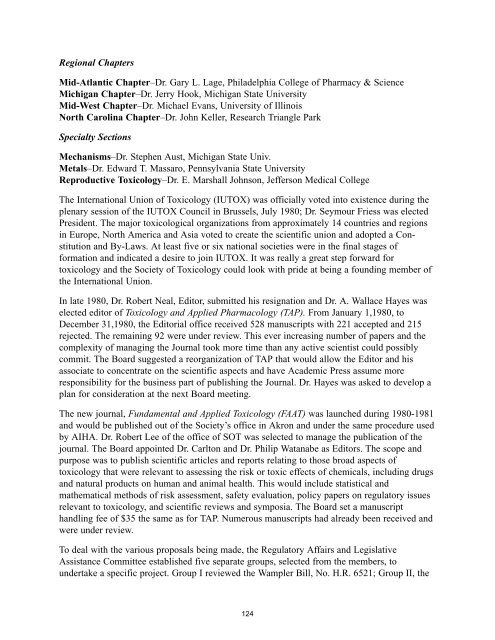SOCIETY O. TOXICOLOGY HISTORY - Society of Toxicology
SOCIETY O. TOXICOLOGY HISTORY - Society of Toxicology
SOCIETY O. TOXICOLOGY HISTORY - Society of Toxicology
Create successful ePaper yourself
Turn your PDF publications into a flip-book with our unique Google optimized e-Paper software.
Regional Chapters<br />
Mid-Atlantic Chapter–Dr. Gary L. Lage, Philadelphia College <strong>of</strong> Pharmacy & Science<br />
Michigan Chapter–Dr. Jerry Hook, Michigan State University<br />
Mid-West Chapter–Dr. Michael Evans, University <strong>of</strong> Illinois<br />
North Carolina Chapter–Dr. John Keller, Research Triangle Park<br />
Specialty Sections<br />
Mechanisms–Dr. Stephen Aust, Michigan State Univ.<br />
Metals–Dr. Edward T. Massaro, Pennsylvania State University<br />
Reproductive <strong>Toxicology</strong>–Dr. E. Marshall Johnson, Jefferson Medical College<br />
The International Union <strong>of</strong> <strong>Toxicology</strong> (IUTOX) was <strong>of</strong>ficially voted into existence during the<br />
plenary session <strong>of</strong> the IUTOX Council in Brussels, July 1980; Dr. Seymour Friess was elected<br />
President. The major toxicological organizations from approximately 14 countries and regions<br />
in Europe, North America and Asia voted to create the scientific union and adopted a Constitution<br />
and By-Laws. At least five or six national societies were in the final stages <strong>of</strong><br />
formation and indicated a desire to join IUTOX. It was really a great step forward for<br />
toxicology and the <strong>Society</strong> <strong>of</strong> <strong>Toxicology</strong> could look with pride at being a founding member <strong>of</strong><br />
the International Union.<br />
In late 1980, Dr. Robert Neal, Editor, submitted his resignation and Dr. A. Wallace Hayes was<br />
elected editor <strong>of</strong> <strong>Toxicology</strong> and Applied Pharmacology (TAP). From January 1,1980, to<br />
December 31,1980, the Editorial <strong>of</strong>fice received 528 manuscripts with 221 accepted and 215<br />
rejected. The remaining 92 were under review. This ever increasing number <strong>of</strong> papers and the<br />
complexity <strong>of</strong> managing the Journal took more time than any active scientist could possibly<br />
commit. The Board suggested a reorganization <strong>of</strong> TAP that would allow the Editor and his<br />
associate to concentrate on the scientific aspects and have Academic Press assume more<br />
responsibility for the business part <strong>of</strong> publishing the Journal. Dr. Hayes was asked to develop a<br />
plan for consideration at the next Board meeting.<br />
The new journal, Fundamental and Applied <strong>Toxicology</strong> (FAAT) was launched during 1980-1981<br />
and would be published out <strong>of</strong> the <strong>Society</strong>’s <strong>of</strong>fice in Akron and under the same procedure used<br />
by AIHA. Dr. Robert Lee <strong>of</strong> the <strong>of</strong>fice <strong>of</strong> SOT was selected to manage the publication <strong>of</strong> the<br />
journal. The Board appointed Dr. Carlton and Dr. Philip Watanabe as Editors. The scope and<br />
purpose was to publish scientific articles and reports relating to those broad aspects <strong>of</strong><br />
toxicology that were relevant to assessing the risk or toxic effects <strong>of</strong> chemicals, including drugs<br />
and natural products on human and animal health. This would include statistical and<br />
mathematical methods <strong>of</strong> risk assessment, safety evaluation, policy papers on regulatory issues<br />
relevant to toxicology, and scientific reviews and symposia. The Board set a manuscript<br />
handling fee <strong>of</strong> $35 the same as for TAP. Numerous manuscripts had already been received and<br />
were under review.<br />
To deal with the various proposals being made, the Regulatory Affairs and Legislative<br />
Assistance Committee established five separate groups, selected from the members, to<br />
undertake a specific project. Group I reviewed the Wampler Bill, No. H.R. 6521; Group II, the<br />
124
















